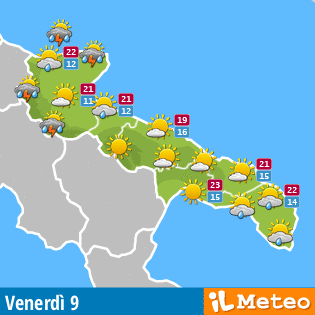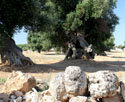Gallipoli
Info Gallipoli
-
Region:
Provincie:
Municipality:
CAP:
Area code:
Surface:
Population:
city hall:
-
Apulia
Lecce
Gallipoli
73014
0833
40,35 Kmq
20.259
Via Antonietta De Pace 78
The enchanting old town centre of Gallipoli standing on an island
Kalé polis, the beautiful city. This is the name the Greeks gave it. Gallipoli is sited along the west coast of the Salento peninsula; it overlooks the Ionian sea and appears divided into two different parts that is to say the suburb and the old town centre, which are bound together by a 17th - century stone bridge with seven spans. The suburb is the result of the modern expansion of the city and it lies on a peninsula towards the Ionian sea. The old town lies on an calcareous island surrounded by powerful walls, on which it is possible to take a walk admiring the beautiful view.
There are some doubts about its origins; some scholars think it was founded by Greek colons coming from Sicily, some others assert that it is the ancient Messapic city of Alezio. Surely Gallipoli was a colony of the Magna Grecia which dominated on a wide territory, including the present Porto Cesareo, before becoming a roman "municipium". During the Middle Ages the city, which was under the control of the Roman Church, has been the scene of terrible battles with the Greek monks who were present all over the Salento. At the beginning of the Middle Ages Gallipoli has been almost surely sacked by Vandals and Goths; then it was rebuilt by Byzantines and experienced a period of social and economic prosperity thanks to its geographic position.
In 11th century Gallipoli was conquered by Normans as the whole Apulia and subsequently, in 1268 with Carlo I d'Angiò, it passed under the power of the Angioini. The town expanded greatly during the Borboni’s domination becoming part of the Regno di Napoli; Ferdinando I di Borbone made the city the most important pole in trading oil for lamps in the Mediterranean sea, thanks to the building of a port in the 18th century. Gallipoli is famous for its Baroque too, which is different from the typical Baroque of Lecce: Lecce is characterized by stone “laceworks” whereas the cathedral of Gallipoli is marked by the magnificence of its colours being completely decorated by large paintings; that’s why it is defined “Baroque of colours”.
The town is defended by a castle which has been built on the ruins of a previous Byzantine fortress, with a quadrangular plan, different circular towers and one polygonal tower. In 1522 the architect Martini, from Siena, realized the so called Rivellino in order to conform the defensive structures of the castle to the introduction of firearms, on commission of Alfonso II, King of Naples. It is an independent defensive structure situated, separated from the fortress, in the sea and linked with the castle by a drawbridge.
Going on to the old town centre, we reach the cathedral of Sant’Agata, which is realized according to the typical Baroque style, marking the whole zone; it has been built on a pre-existing Romanesque church, which had been built, in its turn, on a pagan tabernacle. Inside we can observe the Latin cross plan and very interesting paintings which date back to the 17th and 18th century; they have been realized by Neapolitan and local painters and, covering nearly the whole surface of the church, make it appear as a real picture-gallery, full of beautiful colours. On the other side of the bridge, the modern town lies on a peninsula.
In the zone facing the old town, it is possible to admire the famous Hellenistic fountain rebuilt in the 16th century, probably on a previous fountain which dated back to the 3rd century B.C.; it is decorated with three relieves representing mythological figures of the three metamorphosis of Dirce, Salmace and Biblide. About one mile out to sea, we find the island of Sant’Andrea which is a precious uncontaminated naturalistic habitat, protected as regional park since 2006.














